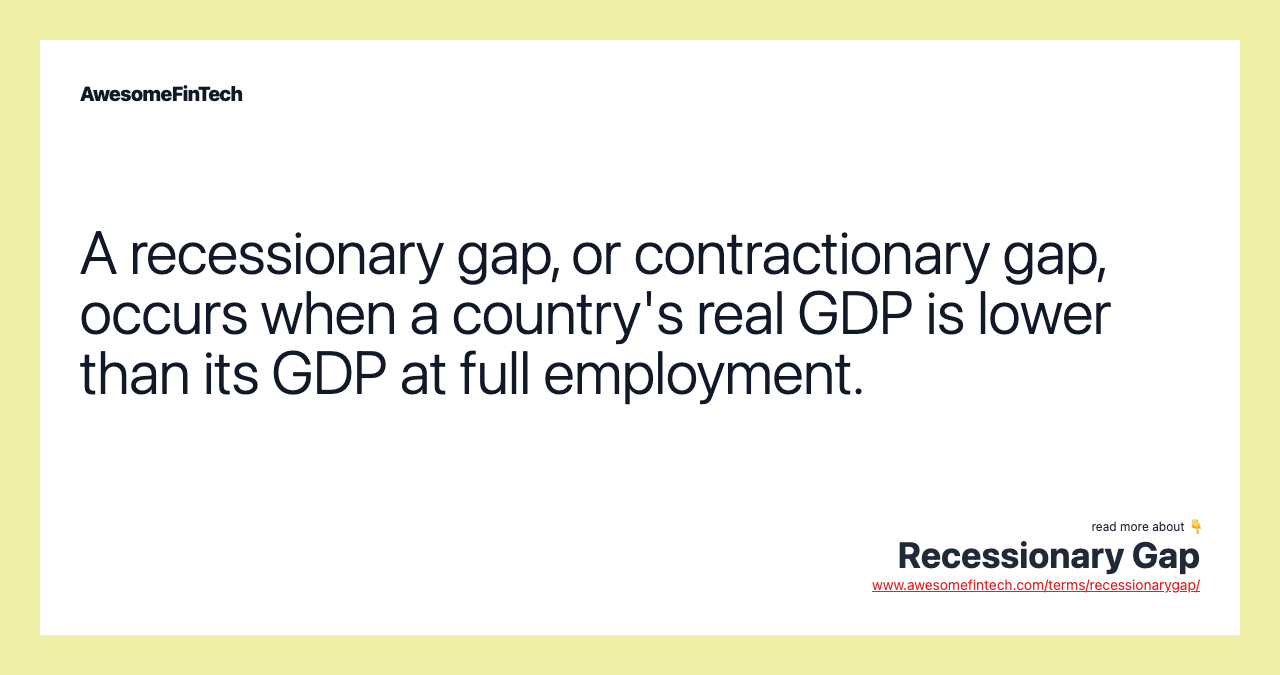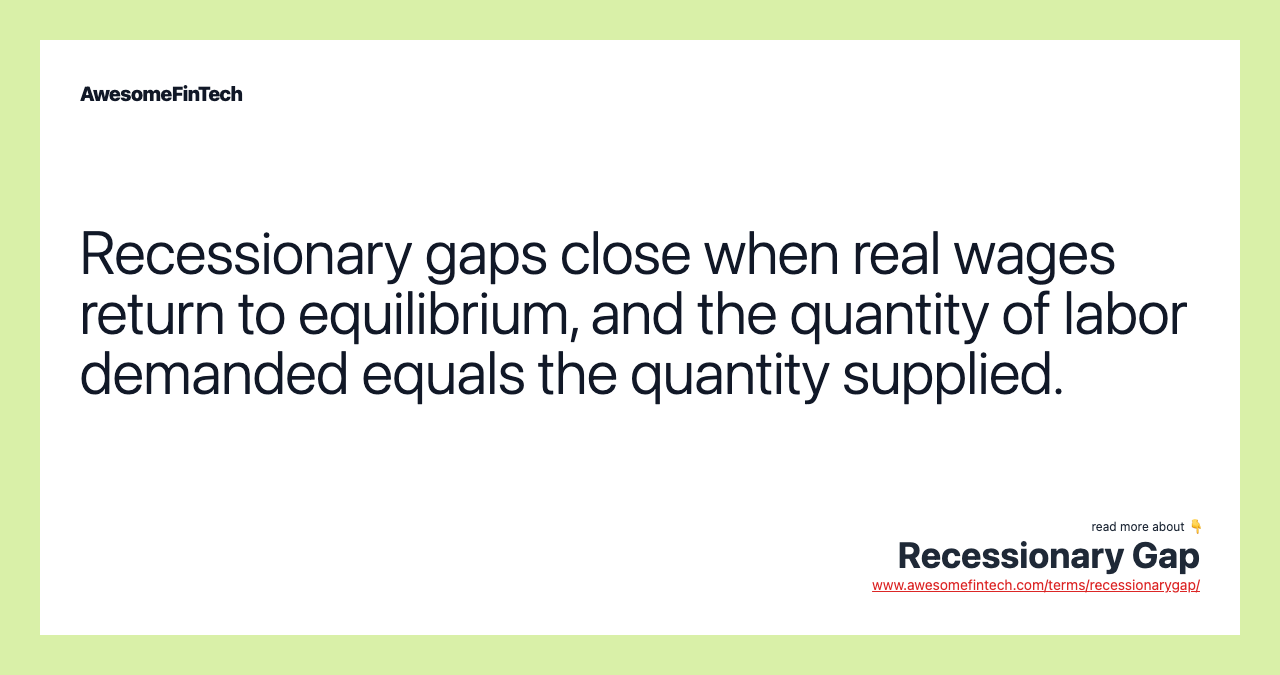Recessionary Gap
A recessionary gap, or contractionary gap, is a macroeconomic term used when a country's real gross domestic product (GDP) is lower than its GDP at full employment. A recessionary gap, or contractionary gap, is a macroeconomic term used when a country's real gross domestic product (GDP) is lower than its GDP at full employment. Economists define a recessionary gap as a lower, real-income level, as measured by real GDP, than the real-income level at a point of full employment. A recessionary gap, or contractionary gap, occurs when a country's real GDP is lower than its GDP at full employment. Although it represents a downward economic trend, a recessionary gap can remain stable, suggesting short-term economic equilibrium below the ideal, which can be as damaging to an economy as an unstable period.

More in Economy
What Is a Recessionary Gap?
A recessionary gap, or contractionary gap, is a macroeconomic term used when a country's real gross domestic product (GDP) is lower than its GDP at full employment.



Understanding a Recessionary Gap
Essentially, a recessionary gap refers to the difference between actual and potential production in an economy, with the actual being lower than the potential, which puts downward pressure on prices in the long run. Often, these gaps are evident during an economic downturn and are associated with higher unemployment numbers.
Significant reductions in economic activity for several months will indicate a recession. During periods of recession, companies will often pull back on spending, creating a gap from the contraction in the business cycle.
Economists define a recessionary gap as a lower, real-income level, as measured by real GDP, than the real-income level at a point of full employment. Real GDP values all goods and services for a specific time-frame, adjusted for inflation. In the period leading up to a recession, there is often a significant reduction in consumer expenditure or investment due to a decrease in the take-home pay of workers.
Recessionary Gaps and Exchange Rates
When production levels fluctuate, prices change to compensate. This price change is considered an early indicator that an economy is moving into a recession and may lead to less favorable exchange rates for foreign currencies.
An exchange rate is merely one country's currency in comparison with that of another country. At parity, the two currencies exchange one for one.
Countries might adopt monetary policies to lower rates in an effort to encourage foreign investment or raise rates to encourage internal consumption of homemade products. The change in exchange rates affects the financial returns on exported goods. Lower foreign exchange rates mean less income for exporting countries and further drives a recessionary trend.
Offsetting Recessionary Gaps
Although it represents a downward economic trend, a recessionary gap can remain stable, suggesting short-term economic equilibrium below the ideal, which can be as damaging to an economy as an unstable period. This instability is because prolonged downward periods of lower GDP production inhibit growth and contribute to sustained higher unemployment levels.
Policymakers may choose to implement a stabilization policy (expansionary policy) to close the gap and increase real GDP. Monetary authorities might increase the amount of money in circulation in the economy by lowering interest rates and boosting government spending.
The Recessionary Gap and Unemployment
A more important outcome of a recessionary gap is increased unemployment. During an economic downturn, the demand for goods and services lowers as unemployment rises. If prices and wages remain unchanged, this can further elevate unemployment levels.
In a cycle which feeds upon itself, higher unemployment levels reduce overall consumer demand, which reduces production, and lowers the realized GDP. As the amount of output continues to fall, fewer employees are required to meet production demand, resulting in additional job losses and further reducing the need for goods and services.
As a company's profits stagnate or decline, it cannot offer higher wages. Some industries may experience pay cuts due to internal business practices, or the effect of economic circumstances. For example, during a recession, people spend less on going out to eat, which means that restaurant workers receive less income in the form of tips.
Recessionary Gap Example
In December 2018, the U.S. labor market as a whole was at full employment with an unemployment rate of 3.7% and there was no recessionary gap. However, not all parts of the country were at full employment, and some individual states were experiencing a recessionary gap.
For instance, New York was at full employment, and most large cities were economically secure. However, the picture was very different in rural areas where jobs were more difficult to find. In West Virginia, for example, the decimated coal mining industry brought the unemployment rate to 5.3% with little economic productivity. Additionally, West Virginia was one of four states with a poverty rate above 18%.
Related terms:
Above Full Employment Equilibrium
Above full employment equilibrium refers to an economy operating at a level where its real GDP temporarily outstrips its potential level. read more
Below Full Employment Equilibrium
Below full employment equilibrium occurs when an economy's short-run real GDP is lower than that same economy's long-run potential real GDP. read more
Business Cycle : How Is It Measured?
The business cycle depicts the increase and decrease in production output of goods and services in an economy. read more
Currency
Currency is a generally accepted form of payment, including coins and paper notes, which is circulated within an economy and usually issued by a government. read more
Demand
Demand is an economic principle that describes consumer willingness to pay a price for a good or service. read more
Depression
An economic depression is a steep and sustained drop in economic activity featuring high unemployment and negative GDP growth. read more
Economy
An economy is the large set of interrelated economic production and consumption activities that determines how scarce resources are allocated. read more
Equilibrium
Equilibrium is a state in which market supply and demand balance each other, and as a result, prices become stable. read more
Exchange Rate
An exchange rate is the value of a nation’s currency in terms of the currency of another nation or economic zone. read more
Expansionary Policy
Expansionary policy is a macroeconomic policy that seeks to boost aggregate demand to stimulate economic growth. read more